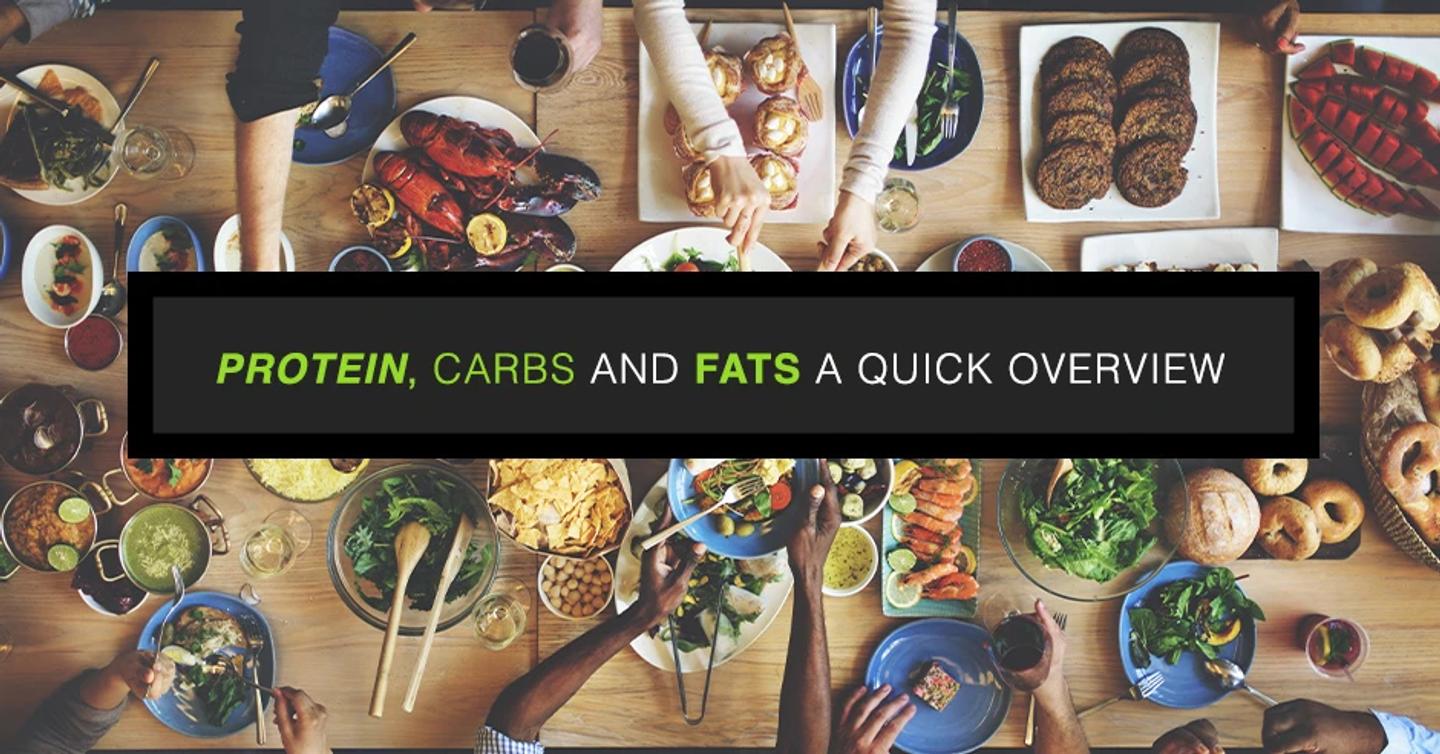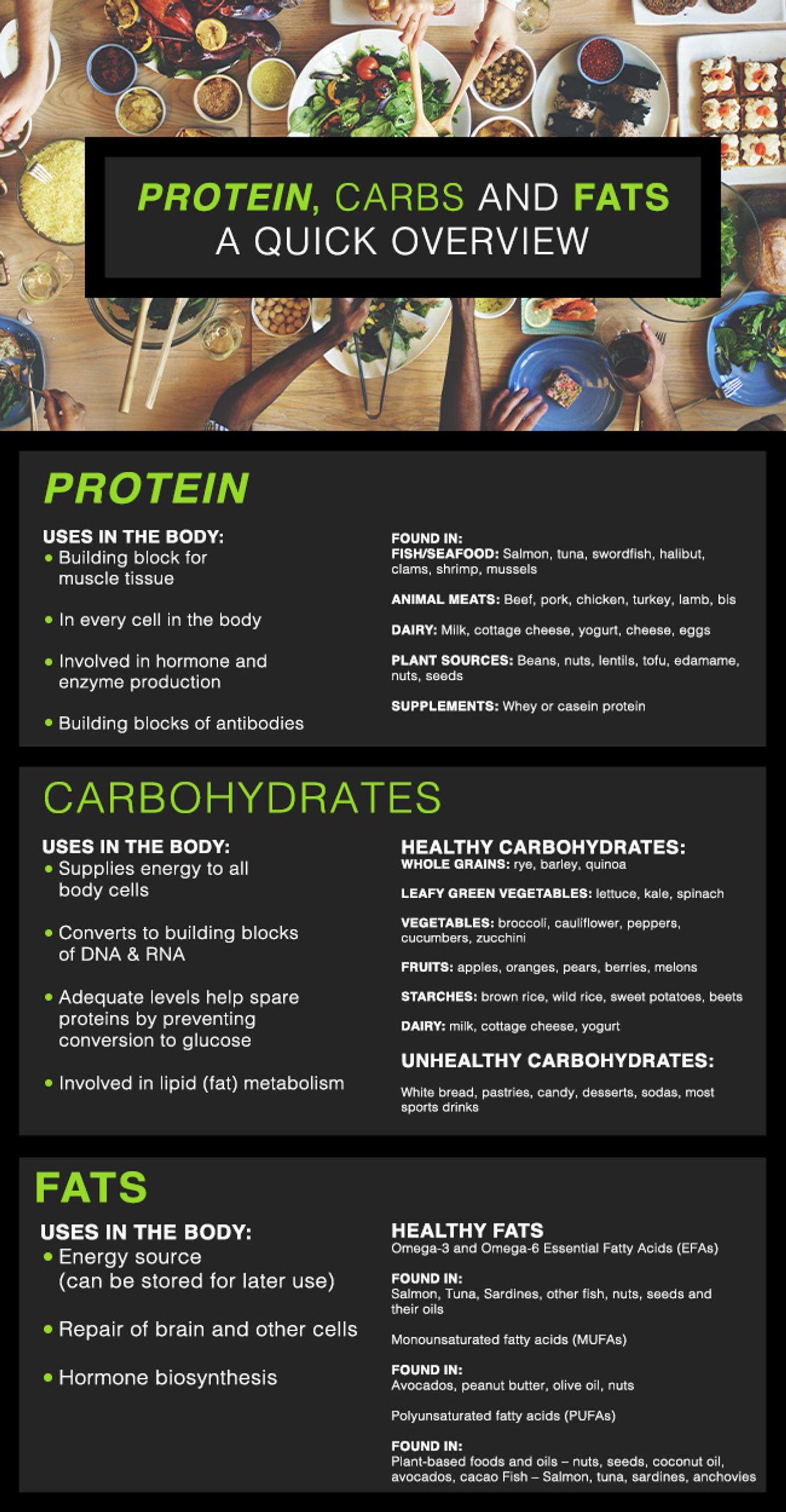
Protein, Carbs, and Fats: A Quick Overview
Reading Time: 6 minutes 32 seconds
BY: ISSA
DATE: 2019-05-24
If you've been around fitness for more than 12 minutes, you know that one of the most common, and most complex, questions in fitness is "what should I eat?"
Protein, carbs, and fats. Simple, right? Just tell your clients to eat these three things and they'll fill all the needs their body has, get strong and lean, and solve your weight dilemma forever.
You're welcome. Peace out.
Unfortunately, the truth is that it's not always that easy; one simple answer just leads to more questions and confusion:
How many calories should I eat each day?
How much protein (fat, carbs) should I eat?
What kind of proteins are best?
Should I eat carbs at night? After my workout? Never?
What do you mean I need to eat fats?!
These questions, of course, barely scratch the surface. And that doesn't even include questions on any of the diet plans out there: Vegan, Keto, Elimination, Paleo, cleanse diets, and so many more. The real nuts and bolts of any nutrition plan is knowing what you're actually eating and how much.
Before even thinking about choosing a nutrition plan, you should have a baseline understanding of essential macronutrients—protein, fats, and carbohydrates. Knowing what they are and what they do can help you and your clients decide which foods belong in their individual nutrition plan and which don't. Let's begin with fats.
Fats Are Not Your Enemy. Mostly.
For over 50 years, medical science, the government, and even big pharmaceuticals have been telling us that fat is the enemy. Yet fats are necessary in the human body. So, what are they and what do they do?
Fat is an excellent source of energy for the body because it has high caloric density relative to carbs and protein (9 kcal/gram vs. 4 kcal/gram) and can be stored for later use. It's that storage part that we're all trying to minimize, of course.
Your brain has a million reasons to want fat in your diet. Neurons transmit signals through the brain and nervous system. Fatty acids help to create and repair the protective coating around them, called a myelin sheath. Healthy myelin means faster signals from the brain, which means you're smarter, faster, and stronger. Okay, that last part might be a stretch, but without myelin, nothing happens.
Also, fats are essential for regulating hormones. Hormones regulate body functions including reproduction, digestion, temperature, muscle function, sleep, and cell growth.
Your body needs dietary fats, but what kind of fats should you encourage clients to eat and how much?
When it comes to dietary fats, there are three helpful or "healthy" fats and two harmful fats. Let's review. First, the "good guys."
Omega-3 and Omega-6 essential fatty acids (EFAs) - Called essential because the body can't synthesize them, they must be acquired from food. While too much Omega-6 may increase heart disease risk1, you need both for good health. EFAs are important for brain function, vision, cardiac health, skin and hair health, and fighting inflammation. They're available from fish like salmon, tuna, and sardines, along with nuts and seeds and their oils. Supplements like fish and krill oil are also rich in Omega EFAs.
Monounsaturated fatty acids (MUFAs) - You can find this in a variety of foods and oils, including avocados, peanut butter, olive oil, and nuts. MUFAs support cell health and can help keep your low-density lipoprotein (LDL) cholesterol in check.
Polyunsaturated fatty acids (PUFAs) - EFAs are included in this family of fats. Found primarily in plant-based foods and oils, they help reduce heart disease risk by improving cholesterol profiles. There's also some evidence that PUFAs (mainly Omega-3 and -6 EFAs) help reduce the risk of type 2 diabetes.2
Fats generally considered harmful include:
Saturated fat - Saturated fat sources include red meat, full-fat dairy, and poultry, as well as most animal flesh. Too much in the diet can increase LDL and overall cholesterol levels, putting you at risk for heart disease. Recent research, however, has created some doubt as to whether saturated fat, and higher fat intake overall, is the real culprit in America's obesity "epidemic."
Trans fat - While some of this type of fat occurs naturally (very small amounts are in beef, lamb, and butter fat), the most common sources are what you could call "Frankenfoods." Most trans fats are created in an industrial process called hydrogenation, by which hydrogen is added to the fat molecules in liquid vegetable oils. Sounds yummy, right? If you eat fried foods, frozen pizza, margarine, or microwaveable breakfast sandwiches, you're probably eating trans fats. Even your favorite doughnut shop is probably using oils with trans fats to fry their donuts.
As for how much fat to eat, that depends on your client's nutrition plan. Ketogenic, Low Carb, and even Paleo plans call for higher percentages of total calories from fat than other plans. The 2015 edition of Dietary Guidelines for Americans has no fat intake recommendations other than limiting saturated fat to 10% of total calories.
Carbohydrates in the Garden of Good and Evil
Carbs have recently become the nutritional devil, so to speak. But like fats, you need them, too! One school of thought is that the quality of carbohydrate matters more than the quantity. But it's probably more accurate to say that they both matter. Which ones and how much depends on your client's goals.
Carbohydrates come in a variety of forms, but for us, the most important are:
Sugars - The simplest form of carbohydrate. Common varieties of sugars found in foods are fructose (fruit sugar,) sucrose (table sugar), and lactose (milk sugar.)
Fiber - Complex carbohydrates that come in soluble and insoluble varieties. Both are important for digestion and cardiac health.
Starches - Complex carbohydrates made of many sugars bonded together to create longer "chains." They are slower to digest and absorb into the bloodstream than simple sugars.
Carbs matter because they provide the body with glucose, the primary fuel for physical functions. There are healthy and unhealthy sources of carbohydrates. The healthy ones provide not just energy, but a variety of vitamins, minerals, fiber, and phytonutrients. The unhealthy ones provide energy with a risk of obesity, diabetes, and disease.
Let's look at some examples of both healthy and unhealthy carbohydrates.
Healthy Carbohydrates - Whole grains like rye, barley, and quinoa. Green leafy vegetables like lettuce, kale, and spinach. Veggies like broccoli, cauliflower, peppers, cucumbers, and zucchini. Fruits like apples, oranges, pears, berries, and melons. Brown rice, wild rice, sweet potatoes, and beets are examples of healthy starches. Some dairy products like milk, cottage cheese, and yogurt are healthy carb sources as well.
Unhealthy Carbohydrates - White bread, pastries, candy, desserts, sodas, and even most sports drinks are examples of unhealthy carbohydrates that should largely be avoided.
A great place to start in helping your clients understand carbs is with our article on Tips to Help Clients Understand Carbs.
Protein...Get Your Protein!
In fitness, we like to think of protein mostly as the building block for our gains. But there's more to it than that. Protein is not just for pretty muscles. It's key for healthy skin, hair, nails, bones, cartilage, and blood. It's in every single cell in the body. Protein is kind of an overachiever.
Unlike fat and carbohydrates, the body doesn't store protein. We need to get it from food. Getting enough (and high quality) protein matters if your client wants to be lean, strong, and fit. High quality protein sources include:
Fish/seafood - Salmon, tuna, swordfish, halibut, clams, shrimp, mussels
Animal meats - Beef, pork, chicken, turkey, lamb, bison
Dairy - Milk, cottage cheese, yogurt, eggs
Plant sources - Beans, nuts, lentils, tofu, edamame, nuts, seeds
Supplements - Whey or casein protein
When choosing proteins, remember that most come with "extras." Many beef, pork, and lamb cuts have relatively high saturated fat content. Many plant-based proteins are also high in fiber. Some fish and seafood sources come with a dose of Omega fatty acids. Whey proteins offer the convenience of ease of preparation and portability.
While most people don't really need to increase their protein intake, those who exercise should pay attention to their intake amounts. Those who strength train should aim for a minimum of 1 gram of protein per kilogram of bodyweight each day, according to a common recommendation. But the real gauge should be how well you recover after each training session or workout and how you are progressing toward your fitness goals. Good muscle recovery and steady progress gaining lean muscle and/or losing body fat likely means your protein intake is adequate.
"What should I eat?" Like many answers in fitness, this one is also "it depends." On your clients' goals, on their preferences, and on what is sustainable. But a good place to start in figuring that out is understanding protein, fats, and carbohydrates so you and your clients can make informed decisions.
Interested in becoming a go-to nutrition coach? Check out the ISSA's Nutrition Certification program! This comprehensive certification can help you deliver life-changing nutritional results for your clients.

Click HERE to download this handout and share with your clients!
References
Ramsden, CE, et al., "Use of dietary linoleic acid for secondary prevention of coronary heart disease and death," British Medical Journal, Feb. 2013
Forouhi, Nita, et al., Association of Plasma Phospholipid n-3 and n-6 Polyunsaturated Fatty Acids with Type 2 Diabetes: The EPIC-InterAct Case-Cohort Study. PLOS Medicine, July 2016